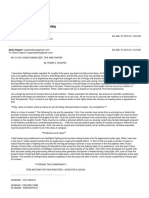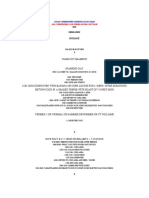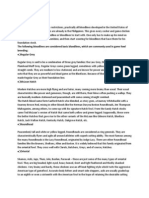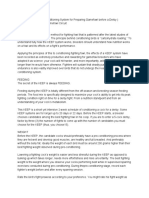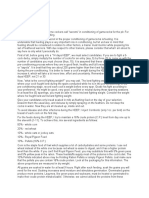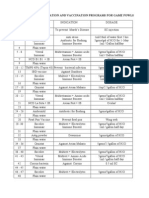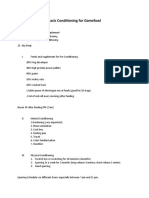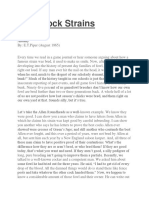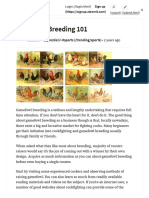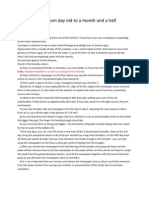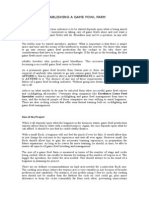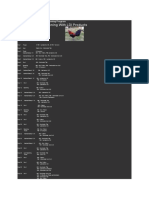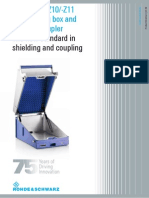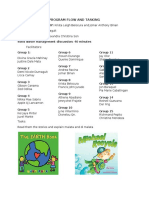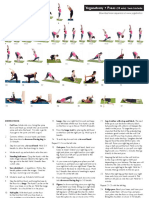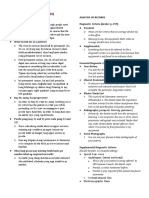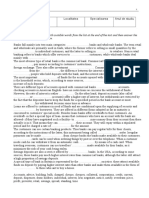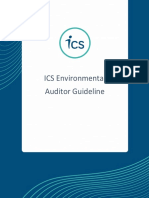14 Day Keep by
14 Day Keep by
Uploaded by
pinkbiikCopyright:
Available Formats
14 Day Keep by
14 Day Keep by
Uploaded by
pinkbiikOriginal Title
Copyright
Available Formats
Share this document
Did you find this document useful?
Is this content inappropriate?
Copyright:
Available Formats
14 Day Keep by
14 Day Keep by
Uploaded by
pinkbiikCopyright:
Available Formats
14 DAY KEEP BY by Teddy Tanchanco I.
Feeding During The KEEP Let me reveal to you what some cockers call "secrets" in conditioning of gamecocks for the pit. For starters, let us talk about feeding. Some cockers say that the secret in the proper conditioning of gamecocks is feeding. It is undeniable that feeding plays a very important role in conditioning, but let us bear in mind that feeding should be considered in relation to other factors, a trainer must monitor while preparing his set of feathered warriors. With due respect to other trainers, please consider that what I am about to say here is only what I personally do. First of all, before going into a "14 days KEEP", we must select candidates. If you are to fight a 5cock derby, simply multiply the number of cocks for an entry (say, 5) by three (3) to come up with the number of candidates you must choose (thus, 15). It is assumed that these cocks went through a pre-conditioning process where they are in good flesh, healthy and full breasted, but without gut fat or "sapola". It is best that they are about 200 grams higher than their best fighting weight observed during the pre-conditioning. It is better to lower a cock's weight during the KEEP rather than to increase it, which will take a lot more time, effort and uncertainty. Remember that we will do a 14-days KEEP, not 21 or 30. Now, "what is the correct fighting weight?" you may ask. The best fighting weight is that weight where your cock fought best during the spars conducted while he is in the pre-conditioning. In the pre-conditioning stage, record each cock's weight before every spar. Grade his fight according to your preference. He might be good, very good, excellent or neutral during these sparring sessions. In at least five (5) sparrings, you must be able to know his best fighting weight. Consider the weight where he fought best as his best fighting weight. Give your candidates only bread soaked in milk as flushing feed on the day of your selection. Deworm them the usual way, and delouse by simply spraying on the feathers. Do not deep the cocks in water. Now they are all cleaned up, inside and out. To avoid disease and other infections during the KEEP, I inject Combiotic (only 1cc. per bird) on the breast of each cock on the first day. For the feeds during the KEEP, I try to maintain a 16% crude protein (C.P.) level from day one up to the eleventh (1-11). To achieve this, mix several ingredients as follows:
50% - whole corn 20% - red wheat 10% - whole oats or jockey oats 10% - Royal Pigeon Feed 10% - Pellets (16% C.P.) Corn is the staple food of fowl which supplies a lot of carbohydrates and some proteins. I use red wheat instead of the white one because red wheat is easier to digest, and it has a higher protein level than the white. If you can't find Royal Pigeon Feed, you may substitute this with 5% green peas and 5% yellow peas in the ration. These feedstuffs supply most of the proteins in the cock's diet. The 10% Pellets indicated above may be Holding Ration Pellets or simply Pigeon Pellets. Just make sure that the pellets you use contain 16% crude protein. Look at the packaging for this information. The above proportions are measured in dry weight. All grains are soaked in water for at least 9 hours. Right after each feeding, soak the grains you will need for the next. Soaking increases seed moisture and stimulates germination. Germinated grains produce more proteins. Legumes, like green peas and soybeans, must be heated or germinated to make their crude protein metabolizable. Otherwise, we cannot utilized the proteins from these grains. Mix the grains with the pellets only at feeding time. You now have what is called your base feed. To this base feed, add some white of hard boiled eggs. Chop finely one (1) white of a hard boiled egg for every four or five cocks. This supplies some proteins and help retain moisture inside the cock's body during this time. Hard boiled egg is given to the cocks all throughout the KEEP (day 1 to 14). Aside from hard boiled eggs, add bulk (fiber), and natural vitamins and minerals to your feed by mixing finely chopped tomatoes or cabbage or lettuce. These veggies should make up 20% of your feed mixture, while the other 80% is from the base feed with hard boiled eggs. We use volume measurements now, instead of weights. If we take one (1) tablespoon as 20%, then we can mix (1) heaping tablespoons of veggies to four (4) heaping tablespoons of the base feed to make a hundred percent (100%). This will be the final make up of your feed from day 1 to 11. Provide the cocks a steady supply of grits from day 1 to 9 of the KEEP. Grits help the cocks digest the feed and keep the gizzard well-exercised. They remain in the gizzard for about a week. Thus, grits are withheld 5 days before the fight to empty the gizzard not only of feeds, but also grits, on fight day. Feed the cocks on a regular basis. Always feed on the same exact time everyday. I give my morning feed at 7 a.m. and the afternoon feed at 4 p.m. Give each cock two (2) heaping tablespoons of the feed mixture mentioned above. This is about 30 to 40 grams of feed per cock. During the day, the cocks should be crop empty by 2 or 3 p.m. to show that their digestive systems
functions well. It takes only six (6) to seven (7) hours for feeds to be digested in the body of the fowl. If one becomes crop-bound before the afternoon feed, take him out of the KEEP. I like cocks which are voracious eaters and fast grinders. These show that their system is really at work. Picky cocks or those which leave feeds in their cups must be experiencing something unpleasant. They must be observed and treated for any disease, and sent back to preconditioning. Try always to observe the cocks in KEEP before, during and after feeding. If possible, observe them the whole day, everyday, and even during their sleep. With this feeding system, we expect the cocks to loose that extra 200 grams off their weight in the beginning of the KEEP. Therefore, daily monitoring of weights is necessary. Weigh the cocks in the morning before feeding. A cock should lower his weight by as much as ten (10) to twenty (20) grams per day and arrive at his best fighting weight on the 11th day of the KEEP or on the last three (3) days before fight day. If one loses 50 or more grams within a span of 24 hours, the cock must be sick or incapable of bearing stress in the KEEP. Back to the pre-conditioning he goes. Three (3) days before the fight, we do the Carbo-Loading Technique.
II. Carbo - Loading Technique Carbohydrates is the main source of energy for cocks in training. Like human athletes getting ready for competition, the gamecock must store enough energy in his body to be used during the fight for his life. The critical days in conditioning which are the last three (3) days before the fight, finds the trainer wanting to load up his gamecock with as much energy as possible to give him that power he will need. This is done by "Carbo-Loading". Simply put, "Carbo-Loading" means the technique of increasing or "loading up" of carbohydrates in the diet of gamecocks during the last three (3) days of the Keep as a part of "pointing". The objective here is to increase the available metabolizable energy (M.E.) in the cock's body that will be used during the actual fight. This is achieved by increasing the caloric content of the feeds given to the fowl. From the 16% crude protein base feed we have given from the first to the 11th day of the Keep, we gradually increase the amount of carbohydrates to 75% or 80% in the last 3 days. Gradually, so as not to upset the digestive system of the cocks. To the base feed, for every 100 grams, add 10% corn, or an equivalent of 10 grams of corn on the 12th day, 20 grams on the 13th day, and 30 grams on the 14th, for a total of 80% corn in the ration on the 14th day. Thus, the total amount of protein decreases, while carbohydrates increases. The usual amount of two (2) tablespoonsful of feed is given to the cocks daily, morning and afternoon. Why use corn? First of all, feeding corn gives your gamecock that "snap" everytime he hits his opponent. Just compare cocks fed with corn to those which are not. Gamecocks that have corn in their diet feel more fleshy or muscular although a bit heavier, while cocks with no corn feel loose to the touch.
Corn is my choice for carbo-loading because corn has the high amounts of carbohydrates (metabolized energy) compared to other feedstuff. The table below shows the amount of nutrients available from common feed ingredients found in grains used as conditioning feeds. We can see that oat groats (dehulled) has the highest metabolized energy (3400 Kilo calories) followed by corn with 3366 Kcal. However, oat groats is also high in crude fats. This will tend to bring about "sapola" or gut fat in the cock. Experience also tells me that feeding more oat groats turn the droppings very green and take away that "snap" from the cock's buckles. Thus I prefer corn which also has high metabolized energy, but low in fats. This metabolized energy is stored in the body of the fowl for at least 2 days before it is transformed into fats if not used during this time. On the last 3 days before the fight, soaking of the grains is usually regulated. Moisture in the body of the cock is dictated by various conditions, both of the cock, and his environment. Because of these, water intake is managed during the last three (3) days of the Keep.
Above data derived from: The Merck Veterinary Manual, Seventh Edition
III. Moisture and Water Management A gamecock's body is at least 65% water. From this fact alone, we can see that water is really an important element in the proper conditioning of our fowl. Let's dig deeper. Why are we so concerned about water and moisture, in the first place? To properly condition cocks, we have what we call their "peak", meaning to say, they are "On Point" or in layman's term, they are in their lowest possible weight, but still with their greatest strength or power. We can effect this through the correct management of moisture and water for the fowl. Water specifically affects a gamecock in training in two ways: 1) as a supply of moisture needed by the body for normal bodily functions, and 2) as a temperature regulator. For digestion, water acts on the grains and pellets as a solvent and helps in fermentation. Feeds taken by the cocks during mealtime are stored in the crop where it undergoes fermentation. At this point, acids, proteins and carbohydrates are further enhanced before they are passed on to the gizzard for further digestion. Thus, whenever a cock gets crop-bound, we must do all we can to empty his crop of the fermented feeds lest he will die from the poisons these might produce. Without the right amount of water, proper digestion and fermentation of feeds will not take place and can endanger the life of your beloved fowl. So, keep a watchful eye on how you feed and water your gamecocks, specially while they are in training. From day 1 to 11 in our conditioning program, water is always present before the cocks right after feeding. Moisture is also assured by soaking the grains overnight. However, on the 12th day, you as a conditioner/trainer must have what I call a clinical eye and be very careful is assessing the condition of each fowl. While observing your fowl, ask yourself the following questions: How much water does your cock consume or drink during the day? One way of doing this is to draw a line
inside his feeding/drinking pot right on the first day of the Keep to remember the actual amount of water you put in each morning. By night fall, get that which remains of the water in the pot and measure it using a graduated beaker. By the tenth day, you can more or less predict how much water each cock will drink in a day. On the 12th day of the Keep, watch how much he drinks. Is the cock eating his usual amount of feeds? How does he respond to carbo-loading? On the 12th day, we have started adjusting the carbohydrates content of the feeds, remember? If the cock has the right amount of moisture in his body by this time, he is suppose to eat the same amount of feeds he is accustomed to. How are his droppings? Are they watery, dry, or moist? We gauge the fowl's body moisture by observing their droppings. By moist, we mean, the droppings do not splatter when voided, but have the right texture and form when dropped. Try stepping on it lightly and if it sticks to your shoe, then it has the right moisture. Also, watch your cock as he defecate or move his bowels. If he is having a hard time passing his stool, he must be too dry. If he is too dry, he won't cut. If he is too wet, he will be sluggish and won't cut accurately. How is the weather? Is it cloudy day, sunny, warm, rainy or hot? During hot summer months, the cock will certainly drink more water to regain lost moisture and at the same time to regulate his body temperature. A feverish cock will drink water more frequently, than a cock which has the right body temperature. Consequently, their droppings will be very watery. The wind also makes the cocks dry. Although their temperature might be alright, loss of water through the skin and feathers is greatly affected by the wind or air current. You might not notice, but your cocks may already be too dry although they would rather stay on the roost because the wind is too cold. During the rainy months, infections abound. These infections like CRD and Coryza make cocks feverish. Cocks might not show the clinical signs at first, but you will notice that they drink often not just to regain moisture but also to regulate body temperature. They are feverish. Get them out of the Keep. The range of a cock's body temperature during the Keep is between 38.5o to 39.5o Celsius. This is their normal body temperature. Use a rectal thermometer to measure your cock's temperature. Finally, how does each cock feel to the touch? This is something no medical or scientific means to tell you. You have to have the feel for properly conditioned cocks. American cockers call this "corky", maybe referring to the light feeling when you hold the cock in your hands. When held, some cocks are full-bodied and heavy, and tight muscled. Some are thin, light and loose, while others are thin, heavy and tight. Still others are thin, heavy and loose. We are looking for a cock which is full-bodied but light and a bit loose. If they feel tight-muscled, they maybe muscle-bound. We don't want this on fight day. Muscle-bound cocks have muscles still suffering from fatigue. When we say "loose", we mean relaxed muscles. Properly toned muscles have that tension and looseness in them. Always check their weight through your record book. Your cock
must be in his best fighting weight. On this 12th day, we are looking for loose muscles because for the next two (2) days we shall try to make the cocks tighter and dryer. If your cocks have been properly conditioned, they will drink less water for the rest of the Keep. In case, on this 12th day, you find your fowl's droppings watery, or too dry, you still have the 13th and 14th day to make adjustments.
IV. Pointing and Troubleshooting The day, Fight Day, is the most critical day when fighting your gamecock. On this day, just hours before the actual fight, the cock's condition must be at its peak. We achieve this through a procedure called Pointing. Pointing is the process wherein the cock is made to be in his lowest possible weight, yet still with his greatest strength. Cocks in this condition are said to be at their "peak" or "On Point". A cock coming to point must have glossy feathers, bright red face, moist droppings, red watery eyes, alert and relaxed, and with normal body temperature. But before pointing your cock, I think some explanation about joining a derby is in order. Derbies are usually held in the evenings up to the early morning hours. In Bigtime Derbies, submission of weights is done a day before and the fight schedule comes out in the afternoon. For smalltime derbies, submission of weights is in the morning on fight day. Morning, before submission of weights, before feeding, limber the cocks in folding scratch-pens and observe their droppings. Wait 'til a cock passes his stool before weighing him. From each cock's weight, subtract 30-50 grams and submit this to the cockpit as the weights of your entries. Bad weight or weight 40 grams over your declared weight is fined during derbies. The cock loses weight during pointing and 30 grams is a more or less safe margin for this. For example, if your actual weight is 2.1 kg., subtract 30 grams from that, and declare 2.070 kg. as the weight of your entry, 2.110 kg. is your bad weight. On the time of fight, your cock will surely weigh less than 2.1 kg. because of pointing. Even if your cock does not lose weight during pointing, you are still in the allowable weight limit. Remember to calibrate your weighing scale to that of the cockpit's where you will fight. Time of fight is also important. A cock digests his normal feed in 6 to 8 hours and fully absorb the nutrients in another 4 to 6 hours. So, try to know your fight schedule to program your feeding time beforehand. If your fight is 6 p.m., count 6 to 8 hours backwards (about 12 noon) and feed your cock his regular ration of pointing feed. By 6 p.m., he must be empty and On Point. When pointing, it is better to under feed than to overfeed. Feel the cock's crop and see that it has nothing in it. If a grain or two can be observed, feed less than his normal ration. Empty crops don't mean that the gizzard and other digestive organs are also empty. To be sure that no feed still exists in the cock's body, feed less.
Now comes the essential part of pointing, moisture. Once in the cockpit, rest the cocks for at least 30 minutes before giving 3 to 5 dips of water. This will encourage bowel movement. As explained in previously, moisture can be gauged only by observing the cock's droppings. There are four (4) stages or sequence of changes that occur with the cock's droppings when we conduct pointing procedures. First is the usual moist and firm droppings which must be seen in the morning just before weighing the cock and after the last feeding. Next, when the cock has emptied his gut of the fibers and other waste materials from the feeds, you will observe what I call "cecal droppings". This is the brown sticky smelly kind of droppings the cock pass from time to time during the Keep. But now, "cecal droppings" is an indication of emptying out of the intestines. You will also observe that some moist green droppings with white toppings still come out but are increasingly getting smaller. When the cock is really empty (from the crop to the large intestines), what I call "moisture droppings" will appear. These look like whitish mucus about two (2) inches in diameter. They become smaller as pointing progresses. The cock may be said to be On Point when the size of moisture droppings are as small as a twenty-five (25) centavo coin and a little bit sticky. A peculiar movement I have observed with cocks On Point is what I call the "head knocking" syndrome. Coming to their peak, the cocks start to knock their heads (something like twitching as in a person with a tic). This must be observed while limbering prior to the actual fight. It is difficult to describe the movement in writing, but once you've seen this knocking movement, this is a sign that the cock is already in his peak. Another sign is when the pupil of the eyes start to dilate. But sometimes, this is not reliable. These are all signs of being at their peak. Be careful not to overshoot their peak lest your cock will be "off". The "off syndrome" comes right after the peak. This means that they have already used up all the nutrients and energy available in their body, and hunger have started taking its toll. Some cockers aver that "off syndrome" is due to drug overdose, constipation or being coop-stale. Often, a drug overdosed cock will be listless. A constipated one will show no interest in fighting since he is preoccupied with his bowel movement and a coop-stale cock is sluggish and sleepy. But primarily, I think the real cause of the "off syndrome" is hunger. You might say that making the cock hungry is what we are doing during pointing. Yes, partly correct, since we withhold feeds, but remember that nutrients are still absorbed by the body even after the grains and other stuff are already digested. Once the nutrients are consumed, hunger will be coupled with lack of energy and essential nutrients which makes the situation very critical and harmful. In pointing, we want the cocks to be empty but not hungry. Thus, while limbering before the actual fight, a cock which is jittery, easily agitated, and crazy for food, is "off". He has his mind on food, not on the fight. To extend the point, you may feed a few grains of cracked corn or teaspoon of your pointing feed a few hours before limbering. To hasten the onset of the point, feed less in your last feeding. The point cannot be maintained once it sets in. It progresses, so time your pointing procedure well that the actual fight falls within the 4 to 6 hours that the peak period is in.
To avoid the "off syndrome", know the right amount and correct administration of drugs you are using. Avoid constipation and coop-staleness by limbering often and checking your room temperature in case it is too cold. Feel the cock for any signs of fever. This is a sure indication of being "off" and sick. If too much moisture is noticed thru the droppings, give a few pellets or cracked corn to draw out body moisture. However, a cock which loses 70 grams or more on fight day must not be fought. He must be sick. If ever he gains weight while pointing (which I think will never happen), there is no cause for alarm if he is empty.
V. Exercises During The KEEP - The Rotation Method There are a thousand and one ways of training a gamecock. Different trainers have different styles and different procedures. In my years of cocking, I have looked up to local and foreign cocking greats whom I happened to meet and have acquainted myself with during those years. Meeting the likes of James Pope and Buddy Mann proved very informative and helpful in my personal quest for proper training of my gamecocks. For James Pope, sparring is the best exercise or training for roosters; for Buddy Mann, it is a combination of natural exercises and table work-outs. From them and from my personal experience, I share to you most of what I know about exercises during the Keep. Since my first sparring session, I have noticed that everytime a cock fights, he pants; he pants heavily specially during summer months; he also pants excessively when he has too much moisture in his body. Therefore, the main concern of a trainer during the Keep is to develop the cock's coping mechanisms to lessen panting. Panting is a sign that the cock's body system is stressed such that his heart beat increases to supply more oxygen to his organs. Respiration is naturally agitated. Exercises further enhance the cock's coping mechanisms. First of all, I would like to make it clear that training a gamecock really begins from the time he was hatched. Proper rearing and nutrition are, for the most part, the backbone of training. One cannot do much in a 21 or 14 day Keep, other than to keep the cocks alert, increase their stamina and tone the muscles. Power comes with breeding, and muscles are developed during the rearing stage and pre-conditioning. Training should help promote flexibility, strength, muscle toning, contouring and cardiovascular endurance. No amount of exertions can improve the constitution, circulatory and respiratory capabilities of sickly birds. So, start them while they are young and properly care for them while they grow. During the Keep, a trainer aims to make the cocks always alert because this is precisely what they need during the battle. Agility, reflex and quick thinking is an asset in fights lasting, sometimes, for just a few seconds. You must avoid what we call "Boredom Disease Syndrome" where the animals mope, become listless and disinterested. Another objective of doing exercises during the Keep is to tone the muscles of the cocks. Toning is different from muscle development as the latter is gained during the growing and pre-conditioning stages, while toning is simply working on what you already have. With toned muscles, the cocks are relaxed, not muscle-bound and never coop-stale.
There are several views regarding training exercises for fightingcocks. Most older cockers before, subscribe to the "manual" or table exercises which mean the trainer's supervision and handling to exercise the cocks. This finds the necessity of various exercises like the "tailing", flies, flips, turnovers, etc. Other advocate the "natural" or not much human interference on the movements of cocks in training. This brought about the Rotation Method and the use of fly pens, and scratch boxes to exercise cocks. Both systems have their own advantages and disadvantages, and I feel a combination of both is necessary to exercise gamecocks properly. The Rotation Method. Rotation here simply means the transfer of cocks from the cord, to the fly pen, to the scratch box, to the resting coops, then back to the cord or tee-pee. For this method, a trainer must have a fly-pen measuring 12' in length, 4' wide and 12' high. If you could have pens with bigger dimensions, the better. There must be an adjustable roost which can be positioned 4, 6, or 8 feet above the ground. The litter floor is a mixture of horse manure, river sand, and garden soil. The loose texture of the ground cushions the cock's landing and also encourage them to do some dusting. The Scratch Box. The scratch box, on the other hand, is made of wood with the following dimensions: 3' long, 3' wide, and 3' high. Make it high enough so that the wings are not obstructed when the cock flaps them. The box should have wooden floors to ensure proper extension of the legs when the rooster scratch with a full swing of the legs extending back. Scratch materials like corn schucks, banana leaves, or hay must be placed in the box. The box is intended for scratching, not dusting, so don't put soil in it. The Tee-pee. The tee-pee or cord area should be their sleeping grounds, and where they catch the morning dew and sun-bathe in the morning. Position your tee-pees facing East or where sunlight casts its rays in the morning. The Coop. A special coop for resting is also needed when you do rotations. This is a small coop measuring 2' wide, 2' long and 2' tall. The cocks are brought here to rest during the day a kind of a siesta place. The rotation is done by transferring the cock from one pen to the other after spending some time in it. When transferring from one pen to the next, always wash the cock's face and legs before placing him in the next pen. Use a mist sprayer with Vet Rx. This opens their lungs and improves their breathing. In the scratch box, encourage scratching by throwing in teaspoon oat groats per bird. For the first day, place a little scratch materials and let the cock scratch for only five (5) minutes. On the second, increase the amount of scratch materials and increase the duration of scratching to 10 minutes. Increase the amount of the scratching materials and the duration of the scratching up to the 7th day where the materials are almost 6 inches deep and the duration of the exercise, 30 minutes long. Starting on the 8th day, decrease the amount of scratching materials and the duration of the exercise in such a way that you reach zero on the 12th day of the Keep. There are different materials used as scratch for light and heavy exercises. I use banana leaves for light scratching done only during the summer months, and use corn schucks or sugar cane leaves
for heavy scratching done only during the cold months. Hay can be classified as an in-between type of scratch material. You yourself must decide whether your cock needs light or heavy exercises and adjust accordingly. Do the scratching exercise when the cock is hungry or else, you will never get the desired results. I place my cocks in scratch boxes as early as 4 in the morning when they start to feel their hunger coming in. After scratching, I pick him up, wash his face and feet, then return him to the tee-pee for sun and dew. By 7 a.m., I feed the cocks their conditioning ration for the day. You may find a discussion on the conditioning feeds I prepare in the I. Feeding During The KEEP. At 9 a.m. take the cocks from the cord, wash their faces and feet, and place each in their respective fly pens until noon. At 12 noon, place them in the resting coops. This resting should not be more than 2 hours to prevent coop-staleness. By 2 p.m. get a pair of the rested cocks and do a "salida" or do a "kahig" and allow them two buckles while holding on to their tails. After the "salida", place the cocks again on cord while they await feeding. During the night, we do the table workouts."
You might also like
- Gmail - Gamefowl Conditioning and Pointing PDFDocument10 pagesGmail - Gamefowl Conditioning and Pointing PDFAlexis OrganisNo ratings yet
- 21 Day Conditioning MethodDocument9 pages21 Day Conditioning Methodonitsuaf86% (28)
- 21 Days Conditioning KeepDocument1 page21 Days Conditioning KeepNiño Embile Dellomas75% (4)
- Lock GenesDocument3 pagesLock Genesbogs8065100% (7)
- Game Fowl BloodlinesDocument4 pagesGame Fowl BloodlinesNel Banas100% (2)
- Frank Shy KeepDocument20 pagesFrank Shy Keepbogs806575% (4)
- Conditioning of AsilDocument8 pagesConditioning of AsilWorrenbuffet Rang67% (6)
- Gamefowl Conditioning Lecture by Sonny MagtibayDocument23 pagesGamefowl Conditioning Lecture by Sonny MagtibaySherwin Camba94% (86)
- Pointing of Fighting CocksDocument1 pagePointing of Fighting CocksDael Gerong100% (2)
- On Gamefowl Breeding by M.L FernandoDocument5 pagesOn Gamefowl Breeding by M.L Fernandobogs8065100% (2)
- Breeding Game Fowl Is A Good Business But Not To OthersDocument23 pagesBreeding Game Fowl Is A Good Business But Not To OthersJen Maramion100% (9)
- Gamecock Breeding Record - Complete Markings SheetsDocument4 pagesGamecock Breeding Record - Complete Markings SheetsByron Pojol86% (7)
- Binary Numbers Gamecock MarkingsDocument1 pageBinary Numbers Gamecock MarkingsByron Pojol67% (3)
- Endangered Species of Plants & Animals in MaharashtraDocument18 pagesEndangered Species of Plants & Animals in Maharashtra27 Hardik Gosavi82% (17)
- The Keep - Feeding (A Conditioning System For Preparing Gamefowl Before A Derby)Document3 pagesThe Keep - Feeding (A Conditioning System For Preparing Gamefowl Before A Derby)Jayden Jacob100% (1)
- Conditioning The Gamecock For BattleDocument19 pagesConditioning The Gamecock For Battlegennoxyd100% (4)
- Conditioning by TJT (14 Days)Document5 pagesConditioning by TJT (14 Days)JN Galaura OcmejaNo ratings yet
- Carbohydrate Loading KeepDocument10 pagesCarbohydrate Loading KeepAbigail Zamora100% (3)
- 14 Days KeepDocument12 pages14 Days KeepVic Balt100% (1)
- Gamefowl ConditioningDocument15 pagesGamefowl ConditioningJN Galaura Ocmeja100% (5)
- Recommended Medication and Vaccination Programs For Game FowlsDocument2 pagesRecommended Medication and Vaccination Programs For Game FowlsKathleen Concepcion82% (17)
- Basic Stag Conditioning: Conditioning Guide and Basic Tips During Training by Sonny Lagon (Blue Blade Farm)Document3 pagesBasic Stag Conditioning: Conditioning Guide and Basic Tips During Training by Sonny Lagon (Blue Blade Farm)boen jayme100% (3)
- Conditioning For GamefowlDocument10 pagesConditioning For GamefowlJN Galaura Ocmeja100% (1)
- Crude Protein List of Gamefowl FeedDocument3 pagesCrude Protein List of Gamefowl FeedKaylouer64% (11)
- Gamecock StrainsDocument187 pagesGamecock StrainsJM Lasquite100% (1)
- Powerpointing 2011Document8 pagesPowerpointing 2011Red Phoenix83% (6)
- Gamefowl Breeding 101 - Steemit PDFDocument10 pagesGamefowl Breeding 101 - Steemit PDFGregorio Austria0% (1)
- Understanding Battle Cock Nutrition and SupplementationDocument22 pagesUnderstanding Battle Cock Nutrition and SupplementationJoy CieloNo ratings yet
- Overpopulation Annotated BibliographyDocument6 pagesOverpopulation Annotated BibliographyAcademic WarriorNo ratings yet
- A Prostitute Who Became A DeityDocument6 pagesA Prostitute Who Became A DeityJames SmithNo ratings yet
- 21 Dsys Conditioning ManokDocument12 pages21 Dsys Conditioning ManokOfficer_cruize86% (7)
- Conditioning The Gamecock For BattleDocument14 pagesConditioning The Gamecock For BattleMaxcarlo Lorenzana100% (2)
- Gamefowl Acf Conditioning ProceduresDocument5 pagesGamefowl Acf Conditioning ProceduresLeo HiddenValley100% (7)
- Linebreeding Aunt-Nephew PDFDocument1 pageLinebreeding Aunt-Nephew PDFbogs806550% (2)
- Powerpointing2011 PDFDocument8 pagesPowerpointing2011 PDFbogs8065100% (1)
- Gamefowl FeedDocument1 pageGamefowl FeedJohn Jill T. VillamorNo ratings yet
- Conditioning GuideDocument4 pagesConditioning GuideAnonymous HmMcaA100% (6)
- Biotech Game Fowl: RoostermanDocument32 pagesBiotech Game Fowl: RoostermanRed PhoenixNo ratings yet
- ChicksDocument7 pagesChicksDonny Ray DonesNo ratings yet
- Fighting Cock ConditioningDocument3 pagesFighting Cock ConditioningVmobile Olongapo67% (3)
- Gamefowl Medication GuideDocument3 pagesGamefowl Medication GuideSherwin Camba100% (14)
- 21-Days Conditioning GuideDocument4 pages21-Days Conditioning GuideYessamin Roderos100% (1)
- Establishing A Game Fowl FarmDocument12 pagesEstablishing A Game Fowl Farmgennoxyd50% (2)
- 21 Day Conditioning MethodDocument17 pages21 Day Conditioning MethodJaneth Mejia Bautista AlvarezNo ratings yet
- 21-Days Fighting Cocks ConditioningDocument7 pages21-Days Fighting Cocks ConditioningDanny FerrerNo ratings yet
- DerbyDocument10 pagesDerbyrayNo ratings yet
- Automated Gamefowl FeederDocument17 pagesAutomated Gamefowl Feederpeque2306100% (1)
- Conditioning Methods - LDI Endorser - Thunderbird EtcDocument17 pagesConditioning Methods - LDI Endorser - Thunderbird EtcSusyary S100% (1)
- 21 Day Conditioning MethodDocument18 pages21 Day Conditioning MethodgennoxydNo ratings yet
- 21 Days KeepDocument9 pages21 Days KeepApple Obias75% (4)
- Claret - Power and Cutting Reach UnlimitedDocument3 pagesClaret - Power and Cutting Reach UnlimitedJustine Bryan Delfino GavarraNo ratings yet
- Gamefowl - Priming For BreedingDocument1 pageGamefowl - Priming For BreedingLester Acosta75% (8)
- Conditioning 2Document8 pagesConditioning 2Rejanath Suarial100% (2)
- Gamefowl Fighting Styles!Document27 pagesGamefowl Fighting Styles!Lawrence TumaponNo ratings yet
- Sit Gamefowl Dec2011Document31 pagesSit Gamefowl Dec2011Aldous BeeNo ratings yet
- The Game Cock: From the Shell to the Pit - A Comprehensive Treatise on Gameness, Selecting, Mating, Breeding, Walking and ConditioninFrom EverandThe Game Cock: From the Shell to the Pit - A Comprehensive Treatise on Gameness, Selecting, Mating, Breeding, Walking and ConditioninRating: 4 out of 5 stars4/5 (2)
- Cocking Science (History of Cockfighting Series)From EverandCocking Science (History of Cockfighting Series)Rating: 3.5 out of 5 stars3.5/5 (3)
- The Royal Pastime of Cock-fighting - The art ighting, and curing cocks of the gameFrom EverandThe Royal Pastime of Cock-fighting - The art ighting, and curing cocks of the gameNo ratings yet
- Feeding Management For Show Lambs: E TensionDocument9 pagesFeeding Management For Show Lambs: E Tensionionut2007No ratings yet
- Racing Pigeon Fanciers Secret WeaponsFrom EverandRacing Pigeon Fanciers Secret WeaponsRating: 3 out of 5 stars3/5 (1)
- Roadrunner Feed MixingDocument3 pagesRoadrunner Feed MixingmaviemutengaNo ratings yet
- General Guidelines For Feeding Sheep and GoatsDocument7 pagesGeneral Guidelines For Feeding Sheep and GoatsFernando AlcantaraNo ratings yet
- 2018 Vimy Dfs Executive Summary Capital Cost EstimateDocument10 pages2018 Vimy Dfs Executive Summary Capital Cost EstimateAnthony OrtizNo ratings yet
- Chapter 9 - Developing A Compensation Plan PDFDocument40 pagesChapter 9 - Developing A Compensation Plan PDFrishabhNo ratings yet
- Convective Heat Transfer CoefficientDocument1 pageConvective Heat Transfer Coefficientjlcheefei9258No ratings yet
- ADIPRIMADocument4 pagesADIPRIMArezabaron88No ratings yet
- AWS Security ChecklistDocument2 pagesAWS Security ChecklistwiredfrombackNo ratings yet
- CMW-Z10 Bro enDocument6 pagesCMW-Z10 Bro enVaibhav SharmaNo ratings yet
- Ch11 QuizDocument6 pagesCh11 QuizcatlovesfoodNo ratings yet
- SY Control CablesDocument3 pagesSY Control Cablesganasaii3882No ratings yet
- Program Flow and TaskingDocument2 pagesProgram Flow and TaskingPink PigNo ratings yet
- Hess 15 BDocument13 pagesHess 15 Bwoodcrafter11No ratings yet
- Pizzaexpress Menu Tre TaDocument2 pagesPizzaexpress Menu Tre TaOliver TillNo ratings yet
- P So As SequenceDocument2 pagesP So As SequencethiagomorettiNo ratings yet
- Orthodontics 2 - Lec (Finals)Document60 pagesOrthodontics 2 - Lec (Finals)Gwyneth MendozaNo ratings yet
- Denture Base MaterialsDocument65 pagesDenture Base MaterialsGitanjali Sharma33% (3)
- Annual ReportDocument158 pagesAnnual ReportKunal BhanNo ratings yet
- WombleDocument12 pagesWomblenitroglicerinoNo ratings yet
- 11 Worldwide Survey of Subsea ProcessingDocument1 page11 Worldwide Survey of Subsea ProcessingVinicius Cantarino CurcinoNo ratings yet
- Study Guide Vocab LWTW CH 11 18Document5 pagesStudy Guide Vocab LWTW CH 11 18no bodyNo ratings yet
- CSP Final Doc MainDocument37 pagesCSP Final Doc Mainnandafailure143No ratings yet
- UT30H English ManualDocument1 pageUT30H English ManualToni NavarroNo ratings yet
- Id 2 FBDocument5 pagesId 2 FBIoan Gheorghe100% (1)
- ECA - An Outpost of ProgressDocument22 pagesECA - An Outpost of ProgressRayane Monteiro ClicksNo ratings yet
- Growing Organic CoffeeDocument4 pagesGrowing Organic CoffeeJhovany77No ratings yet
- AMUL Case StudyDocument4 pagesAMUL Case StudyRicha Garg60% (5)
- Valves 2017-18Document59 pagesValves 2017-18Sethu MadhavNo ratings yet
- UreaDocument1 pageUreaDesiNo ratings yet
- 2018.08.03-ICS - Environmental Auditor GuidelineDocument114 pages2018.08.03-ICS - Environmental Auditor GuidelineXavier BaudequinNo ratings yet
